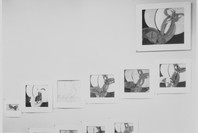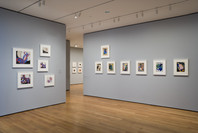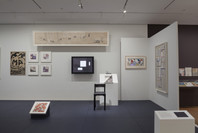Kupka was born in the Czech Republic and settled in Paris in 1896. In 1910 he became one of the first artists to work in a completely abstract mode, developing colorful, visionary paintings and watercolors such as these. They are a product of his mystical belief that rhythmic forms in pure colors can reflect the forces of the cosmos.
Gallery label from Geo/Metric: Prints and Drawings from the Collection, June 11–August 18, 2008.
Kupka seems to have arrived at this and similar composition gradually, beginning in 1907–8 with a drawing of a girl holding a ball in her hand, as if she were about to play or dance with it. He then developed progressively more diagrammatic images of her circular motion, ultimately arriving at a series of fully abstract drawings. In a limited palette of red, blue, black, and white, ribbons of color morph across the page. The radically fluid relationship they establish between foreground and background, line and plane, signals Kupka’s prescient renunciation of the aesthetic conventions of perspective. He made these studies for his manifesto painting Amorpha, fugue a deux couleurs (Amorpha, fugue in two colors), which when it was shown at the 1912 Salon d’Automne, a watershed event in the history of modernist abstraction, was one of the very first abstract paintings to be publicly exhibited in Paris.
Gallery label from Inventing Abstraction, 1910–1925, December 23, 2012–April 15, 2013.



